
Oyster mushroom primordia are often called pins. These are the rudiments of mushrooms that emerge from perforations when the mycelium is completely overgrown.
Details about pin formation
Table of Contents
Why do oyster mushroom primordia not appear in the holes?
Why won't my mycelium pin? Most often this question is asked by mushroom growers who have the following problems:
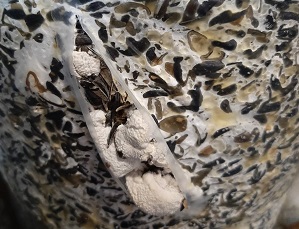 The photo on the right shows that four independent primordia are formed from one slot. The top pins withered, while the other three continued to develop.
The photo on the right shows that four independent primordia are formed from one slot. The top pins withered, while the other three continued to develop.
When the primordia look like in the two photos below, mushroom growers say that the climate in the growing chamber has nothing to do with it.
Since the bunch is the same and grown in the same conditions, but its parts look different.
However, there are several separate bunches here, which were even formed at different times.
Let's take a look at these photos.
There are already grown mushrooms and it seems that a piece of one (whole) cluster just stopped growing. However, these are separate, different clusters that come out of the same perforation!
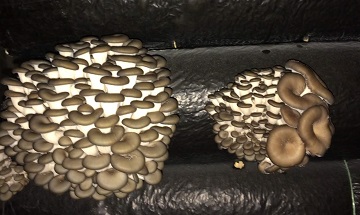

In the first photo, the right primordia came out earlier and there was high humidity in the chamber. Therefore, the shape of the caps is curved, and not all of the mushrooms survived - they are simply no longer visible under those that have grown and covered the dead rudiments with themselves.
And the left part of the cluster is already another primordia, which was formed later, with optimal humidity. Therefore, normal mushrooms were formed. Just like the bunch on the left, in another slot. She got lucky too. She came out later and is developing normally.
In the second picture, there are also three separate primordia. They were all filled with condensate, but only the left part survived - it continued to develop. Perhaps it appeared later and was not damaged so much or was under a film of condensate for less time.
And there are situations like in the two photos below.
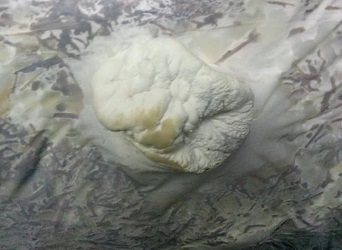
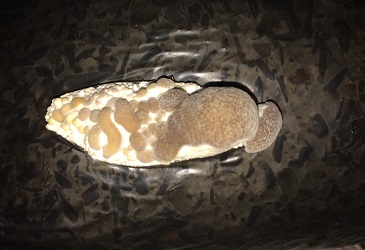
Read about it here
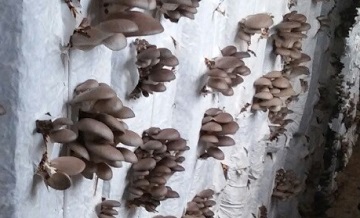 It is necessary to take out bags with a primordial roller (hyphal knots), and preferably with signal primordials.
It is necessary to take out bags with a primordial roller (hyphal knots), and preferably with signal primordials.
If the bags are transferred from the incubator to the chamber earlier, loose oyster mushroom clusters may form.
There is a large amount of carbon dioxide during incubation and this contributes to the formation of a dense large primordia with a large number of mushrooms.
If you take it to a growing chamber where there is air recirculation of 40% or more, there is 950-1000 ppm of carbon dioxide. This is enough to form a normal primordia.
But if only outside air is used, when ppm = 700-800, it is quite possible that a loose cluster will form.
This partly depends on the strain, on temperature, a combination of other factors, but there is a significant dependence on the carbon dioxide content.
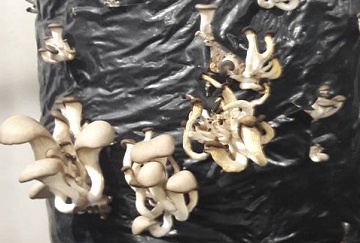 But here everything will dry up, and it’s not at all about carbon dioxide.
But here everything will dry up, and it’s not at all about carbon dioxide.
Here, a loose bunch has formed because there are too many holes.
Through these numerous cuts, there are at least 30 of them throughout the bag, moisture leaves the substrate.
And the mycelium lacks nutrition and water to form normal mushrooms.
This growing chamber also lacks good ventilation, but to be honest, this bag would not produce a crop even in a chamber equipped with an ideal ventilation system.
If the cuts are made at a sufficient distance, they do not interfere with the growth of the oyster mushroom and you have a well-established sales of mushrooms, this is normal.
The main thing is that your ventilation can cope with the removal of CO2 and moisture from a large number of simultaneously grown oyster mushrooms.
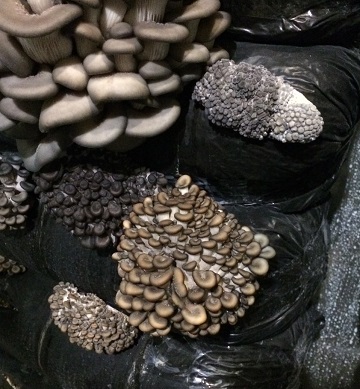
If all the clusters climbed at the same time, they would crush each other. Even now, the more developed cluster on the upper left, oppresses all the others. It must be plucked without waiting until it "grows" in order to give the rest the opportunity to grow. They will also compete with each other, and some of them may dry out.
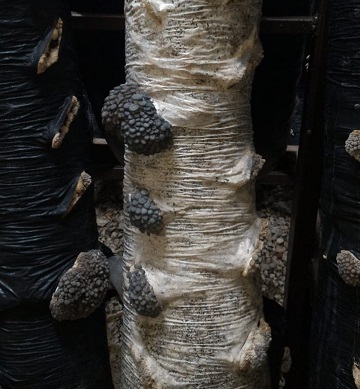
The cuts are poorly placed. Now the primordials do not interfere with each other. But, after a couple of days, when the hats grow up, they will rest against neighboring splices and bags. When making holes, consider the location of the blocks. On this bag, you need to make 2-3 cuts less, anyway, the nutritional value of the substrate is not enough for everyone.
If the oyster mushroom does not grow from holes, this indicates that the air in the incubator was dry (40-60%) throughout the entire incubation period.
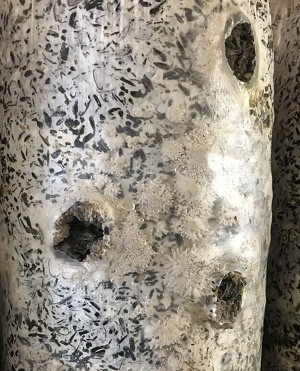
In the illustration on the right, you see white seals under the polyethylene with pronounced mushroom pins against the background of a well-grown substrate, that is, primordia are formed under the film far from the perforations.
Why does oyster mushroom grow inside the bag and not out through the holes?
There are comfortable growth conditions - there is a small supply of oxygen and good humidity for initial development. When the rudiments of fruiting bodies begin to grow under the film, they quickly consume oxygen and suffocate in their own fumes. Therefore, they rot.
If the bag does not adhere tightly to the substrate and air pockets form there, primordia will come out in such places, even if everything is fine with the humidity in the room.
Therefore, when forming blocks, compact the substrate well near the film and tap the bag with the substrate several times on the floor - this way it is better rammed.
You can cut the polyethylene at the site of the formation of the cone - in some cases, a weak oyster mushroom cluster grows out of the cut. But basically this cone just dries up and the mushrooms do not come out of it.
Therefore, it is necessary to observe the norms of moisture during incubation.
Primordia can grow under the film and near the perforations, due to the drying of the upper layer of the substrate in the slot.
You can carefully cut the polyethylene from the bottom and top (by 1 cm, no more) to allow the primordials to bend the film.
From mushroom pins under the film should be distinguished from a dense white mass, which is called stroma.
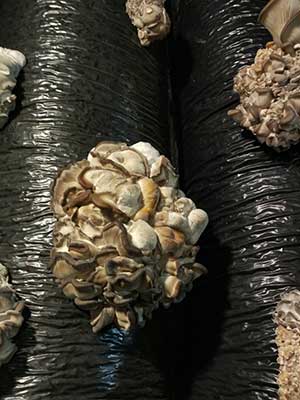
Only one bump or growth of a different shape is formed, an ugly white clot.
Sometimes it even turns gray or brown, and individual mushrooms are visible in the mass.
But such mushrooms still remain twisted and are not divided into separate stems with hats.
Most often, this is due to a sharp waterlogging and moisture condensation at the earliest stage of primordium development - a day or two after the appearance of the primordial ridge (hyphal knots).
Such waterlogging occurs as a result of transferring the block from a warm incubator to a cold growing chamber.
Read about this in the article Why primordia die.
